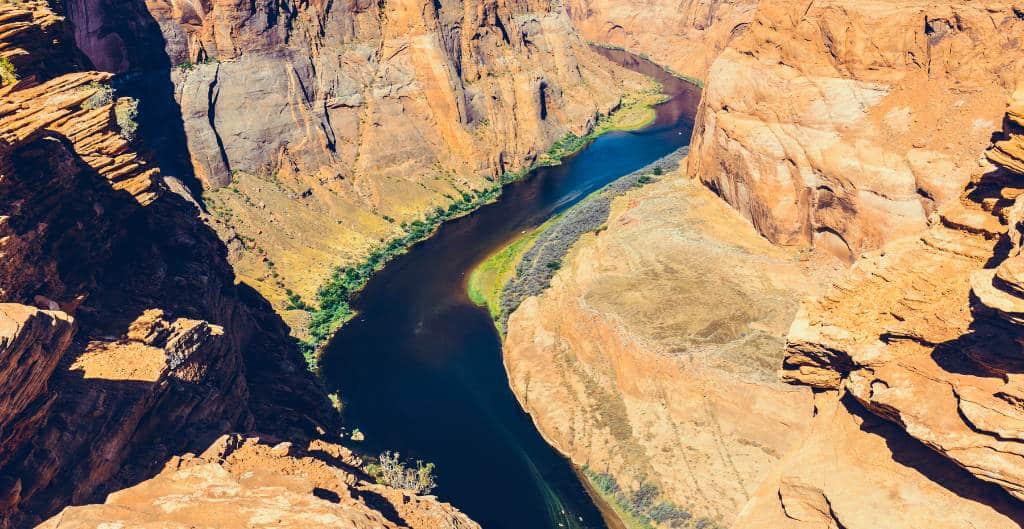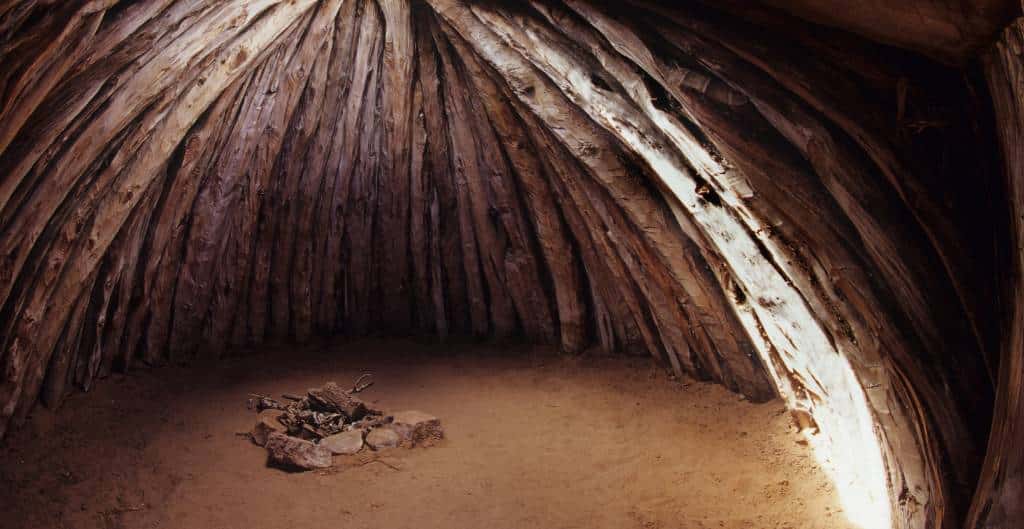Horseshoe Bend, an emblematic geological wonder, is nestled near Page, Arizona, and it is known globally for its jaw-dropping panoramic views. This geological masterpiece, characterized by a distinctive horseshoe-shaped meander of the Colorado River, boasts a 1,000-foot drop to the river below, framed by rugged cliff faces. The site is a harmonious blend of geological formations, vibrant rock layers, and the tranquil turquoise waters of the Colorado River, making it an unforgettable sight.
Visiting Horseshoe Bend is more than a feast for the eyes—it’s a step back in time, a journey through the Earth’s past. As you navigate the sandy path leading to the overlook, each footstep resonates through millions of years of geological history. Seeing the Colorado River gently carve its path around the rock, just as it has for millions of years, is a tangible testament to the power of natural forces. Horseshoe Bend’s geology offers a unique link to our Earth’s history and it’s an awe-inspiring site that everyone should experience if given the opportunity.

The creation of Horseshoe Bend is an epic tale spanning hundreds of millions of years, echoing the Earth’s geological processes. The formation of this iconic landscape is largely attributed to three primary processes: deposition, lithification, and erosion.
Around 200 million years ago, during the Jurassic era, the region that we now recognize as the American Southwest was an enormous desert, similar to the Sahara we know today, with vast expanses of sand dunes. Over the years, these dunes shifted and were buried by additional layers of sand. As the pressure on these layers increased over time, and minerals seeped into the sand, lithification occurred. This process transformed the layers of sand into a compact, solid rock known as Navajo Sandstone. Navajo Sandstone, prevalent throughout the region today, forms the stunning cliffs of Horseshoe Bend.
After the formation of the Navajo Sandstone, additional sedimentary rock layers, including mudstone, calcite, and limestone, were deposited on top. This continued layering of various rock types over millions of years contributed to the area’s distinct stratified appearance.
Approximately 5–6 million years ago, tectonic uplift of the Colorado Plateau caused the Colorado River to cut deeply into the sandstone, creating the entrenched meander seen today. This uplift increased the river’s gradient and erosive power, helping sculpt the dramatic cliffs that surround Horseshoe Bend.

While these geological processes were unfolding, the Colorado River was carving its path through the landscape. The process of erosion played a significant role in shaping Horseshoe Bend. The river, following its natural course, took the path of least resistance, cutting through softer rock layers while leaving the denser Navajo Sandstone relatively intact. This consistent erosion over millions of years formed the deep, sweeping curve of the river that defines Horseshoe Bend today.
The unique horseshoe shape of this geological marvel is due to a phenomenon known as “meandering,” a common feature in mature rivers. On the outside of the bend, where the river’s velocity is higher, there’s more erosion, leading to a deepening of the canyon. Conversely, on the inside of the bend, where the river flow is slower, more deposition occurs.
The dynamic interplay between these geological processes—deposition, lithification, and erosion—over vast spans of geological time, sculpted the breathtaking landscape of Horseshoe Bend we see today. It stands as a monument to the power of natural forces and the grandeur of geological time.
Horseshoe Bend features a nearly 1,000-foot vertical drop from the overlook to the Colorado River.
The river continues to erode the rock, slowly reshaping the bend over time. Geologists predict that natural bridges may form in the far future.
Horseshoe Bend is part of the Glen Canyon National Recreation Area and is managed by the Navajo Nation, highlighting both its natural and cultural significance.

The human history of Horseshoe Bend is both rich and complex, reflecting a diverse range of cultures and influences over the centuries.
Long before Horseshoe Bend became a popular tourist attraction, it was home to indigenous peoples. Archaeological evidence shows that the region has been inhabited for over 10,000 years, with tribes such as the Ancestral Puebloans and later the Paiute and Navajo people living in and around the area.
The Ancestral Puebloans, also known as the Anasazi, were known for their sophisticated architecture, including cliff dwellings and pit houses. They also developed advanced agricultural practices, growing crops such as maize, beans, and squash. Evidence of Ancestral Puebloan habitation can be found in the form of pottery, petroglyphs, and other artifacts throughout the region.
The Paiute and Navajo people also have a deep connection to the land. The Navajo, in particular, have a rich history and culture that is deeply intertwined with the landscape. They believe in a strong spiritual connection with the land, and many of their stories, rituals, and ceremonies reflect this.

In the 19th century, with the westward expansion of the United States, European-American settlers began to arrive in the region. This period marked the beginning of significant changes and challenges for the indigenous people, with conflicts over land, resources, and cultural differences. The infamous “Long Walk” in 1864 saw the forced relocation of the Navajo people, many of whom were later allowed to return to their ancestral lands.
In the modern era, Horseshoe Bend has become a significant tourist destination, attracting visitors from around the world with its stunning landscapes and fascinating geology. It’s also an important site for the local Navajo Nation, both for its cultural significance and as a source of economic revenue.
Access & Fees: As of 2025, parking is $10 per passenger car, and there is a 1.5-mile round-trip hike to the overlook.
Trail Details: The trail is sandy and can be hot during midday. It takes roughly 30–45 minutes to reach the overlook at a moderate pace.
Best Viewing Times: Sunrise and sunset provide the most dramatic lighting and fewer crowds for photos.
In summary, the human history of Horseshoe Bend is a tapestry woven with threads from many different cultures, each leaving its own unique imprint on the landscape. From the ancient Ancestral Puebloans to the Navajo and Paiute, to the European-American settlers and modern-day visitors, each has played a role in shaping the history of this extraordinary place.

To fully appreciate the geology and history of Horseshoe Bend, consider taking a guided tour with an expert from Grand Canyon Adventures from Flagstaff. We provide practical advice for your visit, such as the best time of day to go and safety precautions to keep in mind. A guided tour of Horseshoe Bend will also offer insights into the geology, human history, and ongoing research in the area. We handle all the logistics, transportation, and planning so you don’t have to!
Horseshoe Bend, an awe-inspiring geological marvel, offers visitors a unique opportunity to witness and learn about the Earth’s geological history, all while experiencing breathtaking views. Take a guided tour of Horseshoe Bend or plan a visit on your own. Whether you’re a geology enthusiast, history buff, or simply a lover of natural beauty, Horseshoe Bend is a destination not to be missed.
What is the best time of day to visit Horseshoe Bend?
The best times to visit are sunrise and sunset, when the lighting highlights the dramatic colors of the cliffs and the river. Early morning also offers fewer crowds and cooler temperatures for hiking the 1.5-mile trail to the overlook.
How was Horseshoe Bend formed?
Horseshoe Bend was formed over millions of years through erosion by the Colorado River, deposition, and lithification of sand into Navajo Sandstone. The uplift of the Colorado Plateau increased the river’s erosive power, carving the iconic horseshoe-shaped meander we see today.
Is Horseshoe Bend accessible for families and children?
Yes, the trail to the overlook is moderate and family-friendly, though it is sandy and can be hot during midday. Children under 5 may need extra supervision, and strollers may be difficult on the sandy path.
Are there any fees or permits required to visit Horseshoe Bend?
Yes, there is typically a $10 per vehicle parking fee for visitors. Please visit horseshoebend.co for the most current parking rates. No additional permits are required for general sightseeing, but commercial tours may require separate approvals from the Navajo Nation.
How long does it take to hike to Horseshoe Bend?
The round-trip hike is approximately 1.5 miles and typically takes 30–45 minutes at a moderate pace. Plan extra time for photos and enjoying the overlook safely.
Can I learn about the geological and cultural history of Horseshoe Bend during my visit?
Absolutely! Guided tours with Grand Canyon Adventures provide in-depth explanations of Horseshoe Bend’s geology, Navajo cultural significance, and human history. These tours also handle logistics like transportation, making the experience seamless.